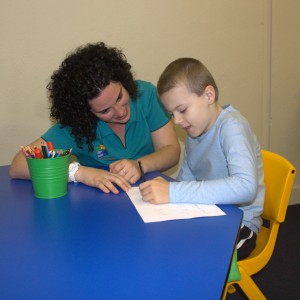 Whether you are a teacher, child care worker or support worker you want the children in your care to get as much learning from the time you spend together as possible. Whether you are in a classroom or small group setting, or providing one on one support, there are lots of things you can do to help ASD kids get the most out of your time together. If you are a parent why not share these ideas with your child's teacher or support worker.
Whether you are a teacher, child care worker or support worker you want the children in your care to get as much learning from the time you spend together as possible. Whether you are in a classroom or small group setting, or providing one on one support, there are lots of things you can do to help ASD kids get the most out of your time together. If you are a parent why not share these ideas with your child's teacher or support worker.
Here are our ideas for maximum learning:
1. Reduce visual distractions. Learning environments for kids are often bright, colourful and busy. While this is cheerful and looks like fun, for children with ASD, it can be over stimulating and full of distractions.
Visual distractions are usually easy to notice as the child will turn to look at them rather than focusing on their task. Things that move such as hanging mobiles or people walking past a window are distracting for some children. Other are distracted by things that catch their interest such as a poster of their favourite TV character or a computer screen in the room.
To minimise visual distractions think about:
- a calm looking environment with clear spaces and soft colours when possible.
- minimising decorations in areas where distractable children need to focus
- getting down to the child's line of vision and looking at what they can see. Can you sit them differently, perhaps facing a wall with less distractions?
- reducing clutter by moving things to another area or placing things in plain coloured boxes when not in use.
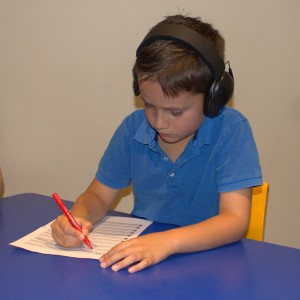 2. Minimise noise. Noise is an issue for many children and for adults too. Most children focus better in a quiet environment but some are very sensitive to noise and may find it hard to focus even when others are not aware there is noise.
2. Minimise noise. Noise is an issue for many children and for adults too. Most children focus better in a quiet environment but some are very sensitive to noise and may find it hard to focus even when others are not aware there is noise.
To minimise noise think about:
- reducing noise by turning off devices when not in use.
- closing doors or using signs to ask other to be quiet during learning times.
- using soft furnishings and rugs to minimise noise reflecting off hard surfaces
- considering using soft, calming background music to mask less pleasant noise
- allowing children who are very sensitive to noise to use headphones or iPods to mask sounds when doing independent work
- helping children to monitor their own attention levels and ask for help if needed such as moving to a quieter area if they cannot focus
- allowing modifications for activities which are hard for some children such as sitting at the back or side at assembly, or coming in after everyone else is seated.
3. Consider issues of touch, taste and smell. Kids with ASD often have oversensitive sensory systems. Some children are sensitive to touching certain textures or to certain smells. This may be an issue particularly in art, craft or other activities such as cooking and even a fruit time or lunch time.
- consider using tools such as tongs so that the child does not need to touch unpleasant textures with their hands
- gradually increase what the child is asked to do, first look, then later smell, then taste
- consider a tissue soaked with an essential oil such as lavender to cover other smells
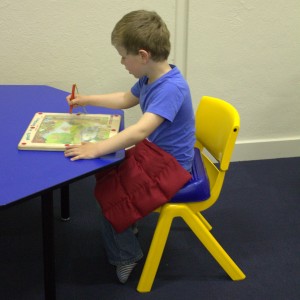 4. Think about seating. Correct seating allows children to have better posture which helps with motor control and attention. For complex children it is worth asking the child's occupational therapist about best seating options.
4. Think about seating. Correct seating allows children to have better posture which helps with motor control and attention. For complex children it is worth asking the child's occupational therapist about best seating options.
Some things to consider include:
- making sure the child has access to any support they need such as wobble cushions or slop desks.
- using the right sized furniture for the child's size.
- it is easier to focus when your feet are supported. If the chair is too high for the child's feet to reach the ground consider placing something under the child's feet to provide support.
5. Check for physical discomfort. Children with ASD are not always good at monitoring their own physical state. They work best when their physical, as well as emotional and sensory needs are met:
- make sure children are not hungry or thirsty when working. Perhaps allow a snack before starting and have a drink bottle available.
- check they are comfortable. Children with ASD often need to be reminded to do things such as remove a jumper when they are too warm or to go to the toilet.
- children who move about a lot may need regular movement breaks. This can be as simple as taking a message to the office or standing up for a quick game of "simon says" or doing some actions to a favourite song.
- some children need sensory stimulation to help them focus such as holding a "fiddle toy" or using a "chewy". Make sure these are available for children who need them.
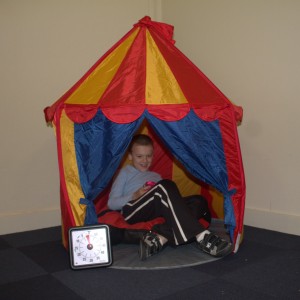 6. Watch for anxiety or over-stimulation. Children with ASD are very prone to anxiety and can become over stimulated with too much sensory or social stimulation.
6. Watch for anxiety or over-stimulation. Children with ASD are very prone to anxiety and can become over stimulated with too much sensory or social stimulation.
- be aware of signs of anxiety or over-stimulation and try to act before a meltdown occurs. Parents can often help others learn the signs for their child.
- favourite quiet activities will calm many children, such as a quiet game of cars or trains, a favourite book or game on the ipad.
- a place to withdraw from sensory stimulation such as a pop up tent, a pile of cushions in a quiet corner or a blanket over a table can help children calm down
- children may show they need a break by running away, hiding under a table or doing something that gets them sent out of class or to the office. Seeing these behaviours as a sign of over-stimulation and acting before they occur can help reduce "behaviour problems".
- some children may just need a quick break such as taking a message to the office or going to wash their hands in the bathroom.
7. Consider motivation. Adults would not go to work regularly and complete tasks consistently if they did not know if they were going to be paid, when and how much. Children work better if they know they will be rewarded, when they will be rewarded, what they will get and what they need to do to get it.
- rewards need to be motivating for the individual child. Some are happy with praise or a sticker, while others need something more tangible. Rewards related to special interests work well for children on the autism spectrum.
- children need to know what the reward is and what they need to do to get it. Use visuals such as schedules or first / then boards to show children what to expect
- be consistent. If you have said three tasks then a reward and the child finishes quickly it is not fair to say "one more". You also need to be consistent if the child does not do what is required. In the beginning it is best to under-estimate what the child can do and allow them to have some success then gradually extend rather than have them fail and not get the reward at the end.
- some children need a series of small rewards within the activity or within the session while others can work right to the end. Again it is better to begin at a level where you are sure the child will be successful and then stretch them a little more each time. Don't stay at a level that is too easy for too long though as you may find the child does not want to move on.
- start with a "big payout" for a small task and gradually make the tasks bigger and the payouts smaller as the child gets into a routine. Keep some big payouts for new tasks, trickier tasks or an extra super effort now and then though.
- use tokens to stretch out a bigger reward over a number of tasks
- use timers to control reward activities as well as tasks
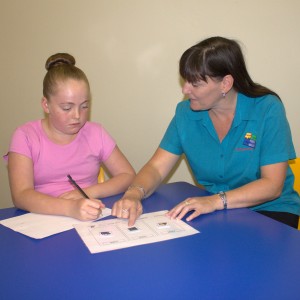 8. Make it predictable with visuals. Children are more settled and focused if they know what is required, what to expect now and what is coming up next. While words and speech are fleeting, visuals are permanent so children can keep referring back to them whenever they need to. Visuals also help children be more independent.
8. Make it predictable with visuals. Children are more settled and focused if they know what is required, what to expect now and what is coming up next. While words and speech are fleeting, visuals are permanent so children can keep referring back to them whenever they need to. Visuals also help children be more independent.
Ways to use visuals:
- Comprehension: A visual can be used alongside a word or simple instruction to help a child understand. For example holding up a picture of a shoe and asking “find your shoes”.
- Managing behaviour: Symbols such as “stop” can be used to mark out of bounds areas such as placing it on a gate to show a child not to go through. A stop sign can also be used to help a child know they must stop a certain behaviour. Visuals can also be used to show children good behaviours, what to do, what the reward is for a good behaviour and what the consequence is for the wrong behaviour.
- Making choices. Objects, photos, pictures and symbols can all be used to help a child make a choice between a number of activities, toys or food. Start with a choice of two and increase as skills develop.
- Indicating needs. Children can learn to point to or hand a visual to an adult to make requests.
- Understanding routines: Visual schedules can show a child what things are happening in the day. This helps them feel secure and helps them move from task to task. Using the visual to show the child a change in routine helps them deal with changes.
- Completion of activities: Using a “first- then” board or visual schedule helps children complete tasks as they can see the reward for their efforts. Adults can gradually extend the number of tasks the child needs to complete to get the reward.
- Managing rewards and break times. Use of a timer can help children move from activities they enjoy and encourage packing up. Timers can be objects such as an egg timer, or electronic such as a timer app on an ipad.
- Teaching new skills. Visuals can be used to show the sequence of activities in a new skill such as washing hands or going to the toilet. They can also show the sequence of actions in a social activity such as joining in play. IPads and iPods can also use videos to teach new skills.
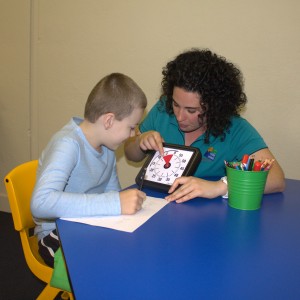 9. Support transitions between activities. Many children with ASD have difficulty moving on to a new activity. Helping children transition well means that they can get the most out of each activity. Try the following to help with smooth transitions:
9. Support transitions between activities. Many children with ASD have difficulty moving on to a new activity. Helping children transition well means that they can get the most out of each activity. Try the following to help with smooth transitions:
- use timers to show the activity is approaching the end
- give a warning that an activity is about to end and allow time to pack up and move on
- use visuals to show when activities will be completed and what is coming next
- have a ritual such as a packing up song to help children move on
- allow the child to carry the visual to the next activity
- have a reinforcer for the child at the beginning of the new activity
10. Remember each child is an individual. What works for one child with ASD may not work for another and kids needs and preferences change over time. You can gain valuable information about a child by working alongside and sharing information with parents and therapists.
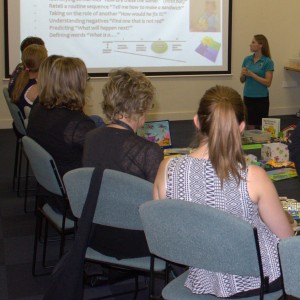 Want to learn more? Talking Matters has workshops in term two about supporting children with ASD in preschool and school. Click here to find out more.
Want to learn more? Talking Matters has workshops in term two about supporting children with ASD in preschool and school. Click here to find out more.
Talking Matters provides assessment, diagnosis, therapy and support for children on the autism spectrum and their families. We are providers under the NDIA. We provide speech pathology, occupational therapy, social skills and play skills groups. We provide services in local schools and our Autism Adviser can help teachers support children who are experiencing difficulties in school. To find out more about our services and our team visit our website.
Our website has a range of downloadable information sheets, printable activities and useful links. To connect with our community of families, therapists and educators join us on Facebook, Twitter and pintrest.
Related Blog Posts
If you liked this post you may also like:
APD in the classroom
Using PICTIONARY to Grow
Use visuals 10 ways!
Preschool procedures



